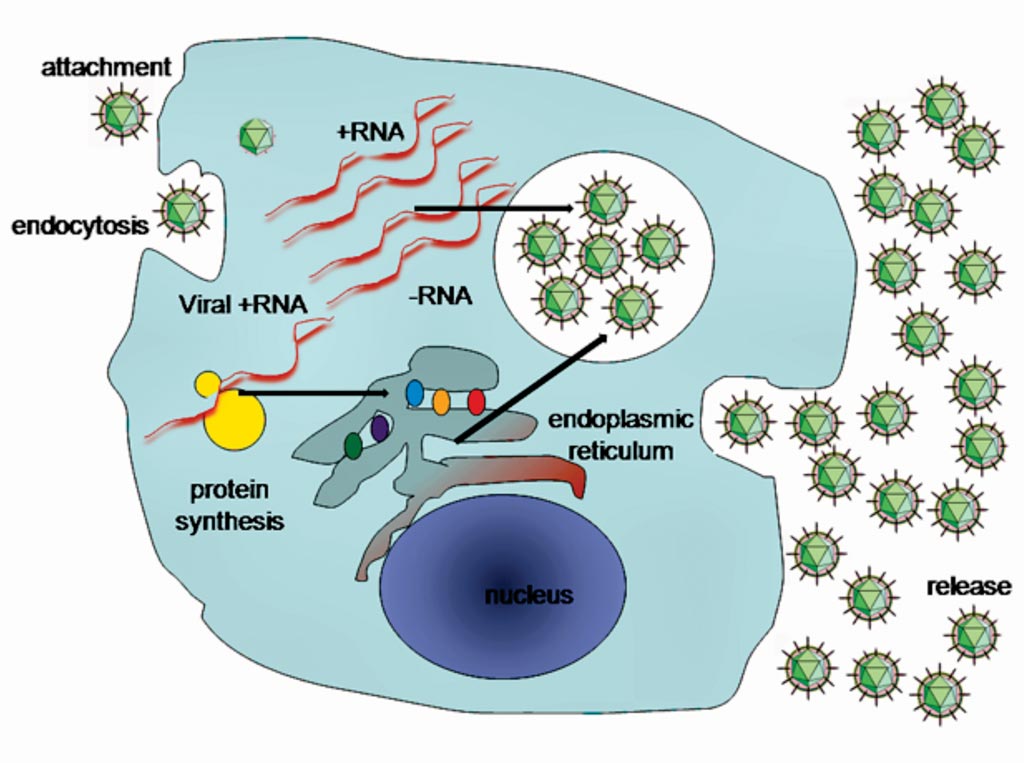HCV-RNA Present in Body Fluids in High Viral Load Patients
By LabMedica International staff writers
Posted on 26 Dec 2018
Hepatitis C virus (HCV) causes both acute and chronic infection. Acute HCV infection is usually asymptomatic, and is only very rarely (if ever) associated with life-threatening disease. About 15%–45% of infected persons spontaneously clear the virus within six months of infection without any treatment.Posted on 26 Dec 2018
There is an ongoing epidemic of HCV) infection among men who have sex with men (MSM). Although epidemiological studies observed an association with certain sexual practices and/or concomitant recreational drug use, the underlying mechanisms of HCV transmission via these routes remains poorly defined.

Image: A simplified diagram of the Hepatitis C (HCV) replication cycle (Photo courtesy of Graham Malcolm Beards, DSc).
Scientists at the Medical University of Vienna (Vienna, Austria) prospectively enrolled 34 Patients with acute (AHC) or chronic (CHC) HCV infection. Rectal and nasal swabs were obtained in all patients and after calibration and validation of the HCV assay, HCV-RNA levels were quantified in swab samples. Fecal occult blood tests were performed to rule out rectal bleeding. The mean age was 43 ± 8 years, the majority of patients (91%; 31/34) were HIV+ and 82% (28/34) were male of whom 64% (18/28) were MSM. Questionnaires were used to assess risk behavior related to recreational drug use and sexual practices.
AHC was observed in 32% (11/34) with all patients being HIV+MSM and 91% (10/11) having a history of sexually transmitted diseases. The most common HCV-genotype (GT) was GT-1a (50%; 17/34) whereas GT-1b, GT-2, GT-3 and GT-4 were observed in 15% (5/34), 3% (1/34), 21% (7/34) and 12% (4/34), respectively. Twenty-three (68%) patients had at least one positive swab sample (56%; 19/34 nasal and 52%; 17/33 rectal), whereas blood contamination was never detected. Individuals with positive swab sample had significantly higher HCV-RNA viremia versus patients with negative swab sample (6.37 IQR 1.06 log IU/mL versus 4.76 IQR 2.54 log IU/mL.
The authors concluded that HCV-RNA is readily detectable in rectal (despite the absence of fecal occult blood) and nasal fluids in patients with AHC/CHC, independently of HIV status, duration of HCV infection or the suspected route of HCV acquisition. Thus, the data strongly suggest that sharing of nasal drug-sniffing 'tools' and unprotected anal intercourse represent high-risk practices for HCV transmission, especially in patients with high serum HCV-RNA levels.
David Chromy, MD, the lead author of the study, said, “We actually did expect to find HCV RNA in the body fluids of our patients. Still we aimed to carefully rule out contamination of rectal fluid by occult bleeding (as a potential confounder) by performing a respective test for occult fecal blood. These bodily fluids may serve as vectors for transmission, still we strongly believe that additional mucosal trauma and/or bleeding is necessary for transmitting HCV-RNA and thus, HCV infection.” The study was presented at the American Association for the Study of Liver Diseases (AASLD; Liver Meeting) in held November 9-13, 2018, in San Francisco, CA, USA.
Related Links:
Medical University of Vienna














